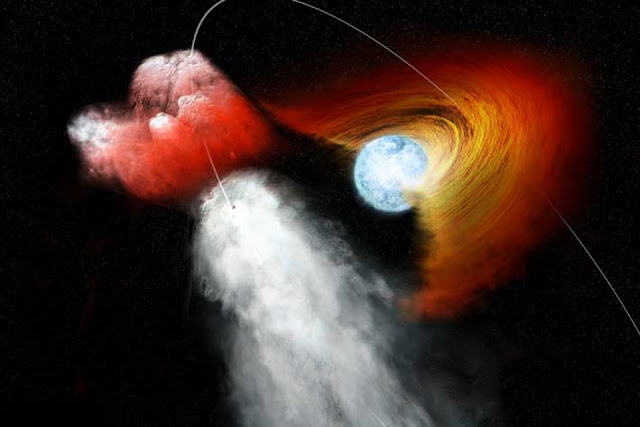| Online: | |
| Visits: | |
| Stories: |

| Story Views | |
| Now: | |
| Last Hour: | |
| Last 24 Hours: | |
| Total: | |
Physicists Track Stellar Material Speeding Through Space
A fast-moving pulsar has blown a hole through the disk whirling around its companion star.A group of George Washington University physicists have identified a spectacular cosmic event: a fast-moving star launching a fragment of material into space at about 40 million mph. The material appears to be picking up speed as it races on, a very unusual occurrence.
The star that launched the matter with enormous speed is known as a pulsar—a highly magnetized, rotating neutron star. Neutron stars are compact remains of supernova explosions.
The researchers compiled data from NASA’s Chandra X-ray Observatory, which is tracking the cosmic projectile, to figure out how a pulsar could create such a powerful blow. The results of the observation appeared in The Astrophysical Journal in June.
“It’s hard to explain a scenario where something is flying through space and not slowing down at all. There is a lot of stuff that it can interact with to slow it down,” said Jeremy Hare, a Ph.D. candidate in GW’s Department of Physics. “Our newest observation shows that it might actually be speeding up, although it’s not fully confirmed yet.”
The pulsar is one half of a binary system, an arrangement of two space objects that orbit around one another.
“The interesting thing about this system is that it is one of only five known binary systems that emit in the very broad energy range from the radio to extreme gamma-rays,” Mr. Hare said.
The pulsar appears to have punched a hole in a disk surrounding the massive companion star and launched a fragment of the stellar disk outward at an extreme speed. The massive star, rotating close to the break-up speed, is spinning off a disk of gas and dust. As the pulsar makes its closest approach to the star every 41 months, it passes through this disk and partially destroys it.
“After this clump of stellar material was knocked out, the pulsar’s wind appears to have accelerated it, almost as if the disk fragment had a rocket attached,” said the paper’s co-author Oleg Kargaltsev, an assistant professor of physics at GW.
Chandra X-ray Observatory will continue monitoring the star system and its moving clump with observations scheduled for later this year and in 2016. The work is a joint project between GW and Pennsylvania State University.
Emily Grebenstein
George Washington University
Source:




